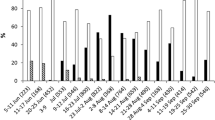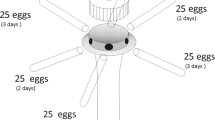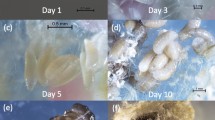Abstract
The performance of A. virlai on six Cicadellidae and three Delphacidae (Hemiptera) species was assessed under laboratory conditions to clarify its host specificity. In addition, the influence of host egg size on the body size and egg load of the emerging parasitoids was investigated. The Deltocephalinae (Cicadellidae) Amplicephalus marginellanus (Metcalf), Amplicephalus dubius Linnavuori and Dalbulus maidis (DeLong & Wolcott) were the most parasitised species. Wasps were unable to parasitise the eggs of the Cicadellinae (Cicadellidae) Hortensia similis (Walker), Plesiommata mollicella (Fowler) and Scopogonalia subolivacea (Stål) or successfully develop in the eggs of A. marginellanus. The parasitism and emergence rates recorded in Delphacodes kuscheli Fennah, Metadelphax propinqua (Fieber) and Peregrinus maidis (Ashmead) (Delphacidae) were lower than in the other parasitised species. Of all the Cicadellidae tested, S. subolivacea laid the largest eggs and D. maidis the smallest. The Delphacidae deposited the smallest eggs of all hopper species evaluated as hosts. Parasitoids emerged from the eggs of A. dubius were larger and carried higher egg loads than the other wasps reared in A. marginellanus and D. maidis. There was no correlation between most measured morphometric variables and the egg load of wasps. Our results provide valuable insights into the host specificity of this egg parasitoid, but further studies are desirable to fully understand how target and non-target hosts affect the population dynamics of A. virlai in the field.



Similar content being viewed by others
References
Almendra Paxtian L, García Martínez O, Robles Hernández VE, Sánchez Peña SR (2021) Cicadomorpha in a vineyard at Parras, Coahuila, Mexico, and vectors of diseases. Southwest Entomol 46:147–152
Alves E, Leite B, Marucci RC, Pascholati SF, Lopes JR, Andersen PC (2008) Retention sites for Xylella fastidiosa in four sharpshooter vectors (Hemiptera: Cicadellidae) analyzed by scanning electron microscopy. Curr Microbiol 56:531–538
Ammar ED, Nault LR (1991) Maize chlorotic dwarf viruslike particles associated with the foregut in vector and nonvector leafhopper species. Phytopathology 81:444–448
Antolin MF, Bjorksten TA, Vaughn TT (2006) Host-related fitness trade-offs in a presumed generalist parasitoid, Diaeretiella rapae (Hymenoptera: Aphidiidae). Ecol Entomol 31:242–254
Bai B, Çobanoĝlu S, Smith SM (1995) Assessment of Trichogramma species for biological control of forest lepidopteran defoliators. Entomol Exp Appl 75:135–143
Barrett M, Schmidt JM (1991) A comparison between the amino acid composition of an egg parasitoid wasp and some of its hosts. Entomol Exp Appl 59:29–41
Berrigan D (1991) The allometry of egg size and number in insects. Oikos 60:313–321
Brentassi ME, Machado-Assefh CR, Alvarez AE (2019) The probing behaviour of the planthopper Delphacodes kuscheli (Hemiptera: Delphacidae) on two alternating hosts, maize and oat. Austral Entomol 58:666–674
Chantarasa-Ard S, Hirashima Y, Hirao J (1984) Host range and host suitability of Anagrus incarnatus Haliday (Hymenoptera: Mymaridae): an egg parasitoid of delphacid planthoppers. Appl Entomol Zool 19:491–497
Corbett A, Rosenheim JA (1996) Impact of a natural enemy overwintering refuge and its interaction with the surrounding landscape. Ecol Entomol 21:155–164
De Oliveira CM, De Oliveira E, De Souza IRP, Alves E, Dolezal W, Paradell S, de Remes M, Lenicov AM, Frizzas MR (2013) Abundance and species richness of leafhoppers and planthoppers (Hemiptera: Cicadellidae and Delphacidae) in Brazilian maize crops. Fla Entomol 96:1470–1481
Dellapé G, Paradell S, Semorile L, Delfederico L (2016) The potential vectors of Xylella fastidiosa from Argentina: a study of leafhoppers and treehoppers (Hemiptera: Auchenorrhyncha) on citrus agroecosystems. Entomol Exp Appl 161:92–103
Dexter E, Rollwagen-Bollens G, Bollens SM (2018) The trouble with stress: a flexible method for the evaluation of nonmetric multidimensional scaling. Limnol Oceanogr Methods 16:434–443
Dietrich CH (2005) Keys to the families of Cicadomorpha and subfamilies and tribes of Cicadellidae (Hemiptera: Auchenorrhyncha). Fla Entomol 88:502–517
Dumón AD, Caro EA, Mattio MF, Alemandri V, del Vas M, Truol G (2018) Co-infection with a wheat rhabdovirus causes a reduction in Mal de Río Cuarto virus titer in its planthopper vector. Bull Entomol Res 108:232–240
EFSA Plh Panel, Bragard C, Dehnen-Schmutz K, Gonthier P, Jacques M-A, Jaques Miret JA, Justesen AF, MacLeod A, Magnusson CS, Milonas P, Navas-Cortes JA, Parnell S, Potting R, Reignault PL, Thulke H-H, van der Werf W, Vicent Civera A, Yuen J, Zappala L, Candresse T, Lacomme C, Bottex B, Oplaat C, Roenhorst A, Schenk M, Di Serio F (2019) Scientific opinion on the pest categorisation of non-EU Cicadomorpha vectors of Xylella spp. EFSA J 17:5736
Ellers J, Jervis M (2003) Body size and the timing of egg production in parasitoid wasps. Oikos 102:164–172
Ellers J, Sevenster JG, Driessen G (2000) Egg load evolution in parasitoids. Am Nat 156:650–665
Gillespie MA, Gurr GM, Wratten SD (2016) Beyond nectar provision: the other resource requirements of parasitoid biological control agents. Entomol Exp Appl 159:207–221
Giménez Pecci MP, Laguna IG, Lenardón S (2012) Enfermedades del maíz producidas por virus y mollicutes en Argentina. Ediciones INTA, Buenos Aires
Hill JG, Luft Albarracin E, Coll Aráoz MV, Virla EG (2019) Effects of host species and host age on biological parameters of Anagrus virlai (Hymenoptera: Mymaridae), an egg parasitoid of Dalbulus maidis (Hemiptera: Cicadellidae) and Peregrinus maidis (Hemiptera: Delphacidae). Biol Control 131:74–80
Hill JG, Aguirre MB, Bruzzone OA, Virla EG, Luft Albarracin E (2020) Influence of adult diet on fitness and reproductive traits of the egg parasitoid Anagrus virlai (Hymenoptera: Mymaridae), a potential biocontrol agent against the corn leafhopper. J Appl Entomol 144:578–588
Hu G, Lu MH, Tuan HA, Liu WC, Xie MC, McInerney CE, Zhai BP (2017) Population dynamics of rice planthoppers, Nilaparvata lugens and Sogatella furcifera (Hemiptera, Delphacidae) in Central Vietnam and its effects on their spring migration to China. Bull Entomol Res 107:369–381
Huber JT (2006) Familia Mymaridae. In: Fernández F, Sharkey MJ (eds) Introducción a los Hymenoptera de la región Neotropical. Sociedad Colombiana de Entomología y Universidad de Colombia, Bogotá, pp 765–767
Jepsen SJ, Rosenheim JA, Bench ME (2007) The effect of sulfur on biological control of the grape leafhopper, Erythroneura elegantula, by the egg parasitoid Anagrus erythroneurae. Biocontrol 52:721–732
Krugner R, Johnson MW, Daane KM, Morse JG (2008a) Olfactory responses of the egg parasitoid, Gonatocerus ashmeadi Girault (Hymenoptera: Mymaridae), to host plants infested by Homalodisca vitripennis (Germar) (Hemiptera: Cicadellidae). Biol Control 47:8–15
Krugner R, Johnson MW, Groves RL, Morse JG (2008b) Host specificity of Anagrus epos: a potential biological control agent of Homalodisca vitripennis. Biocontrol 53:439–449
Krugner R, Johnson MW, Morgan DJ, Morse JG (2009) Production of Anagrus epos Girault (Hymenoptera: Mymaridae) on Homalodisca vitripennis (Germar) (Hemiptera: Cicadellidae) eggs. Biol Control 51:122–129
Lenth, R (2023) Package “emmeans”: estimated marginal means, aka least-squares means. https://cran.r-project.org/package=emmeans. Accessed 15 Feb 2023
Liljesthröm GG, Virla EG (2004) Density-dependent parasitism of Delphacodes kuscheli eggs by Anagrus flaveolus: influence of egg patchiness and density. Biocontrol Sci Technol 14:107–115
Linnavuori R (1959) Revision of the neotropical Deltocephalinae and some related subfamilies (Homoptera). Ann Soc Zool-Bot Fenn Vanamo 20:1–370
Liu F, Bao SW, Song Y, Lu HY, Xu JX (2010) Effects of imidacloprid on the orientation behavior and parasitizing capacity of Anagrus nilaparvatae, an egg parasitoid of Nilaparvata lugens. Biocontrol 55:473–483
Lou YG, Ma B, Cheng JA (2005) Attraction of the parasitoid Anagrus nilaparvatae to rice volatiles induced by the rice brown planthopper Nilaparvata lugens. J Chem Eco 31:2357–2372
Luft Albarracin E, Paradell S, Virla EG (2008) Cicadellidae (Hemiptera: Auchenorrhyncha) associated with maize crops in northwestern Argentina, influence of the sowing date and phenology of their abundance and diversity. Maydica 53:289–296
Luft Albarracin E, Triapitsyn SV, Virla EG (2009) Annotated key to the genera of Mymaridae (Hymenoptera: Chalcidoidea) in Argentina. Zootaxa 2129(1):1–28
Luft Albarracin E, Triapitsyn SV, Virla EG (2017) Egg parasitoid complex of the corn leafhopper, Dalbulus maidis (DeLong) (Hemiptera: Cicadellidae), in Argentina. Neotrop Entomol 46:666–677
Lytle J, Morse JG, Triapitsyn SV (2012) Biology and host specificity of Gonatocerus deleoni (Hymenoptera: Mymaridae), a potential biocontrol agent of Homalodisca vitripennis (Hemiptera: Cicadellidae) in California, USA. Biocontrol 57:61–69
Mansfield S, Mills NJ (2004) A comparison of methodologies for the assessment of host preference of the gregarious egg parasitoid Trichogramma platneri. Biol Control 29:332–340
Manzano C, Virla EG, Coll Aráoz MV, Luft Albarracin E (2022) Ovigeny strategy of the parasitic wasp Cosmocomoidea annulicornis (Hymenoptera: Mymaridae): effect of female age, feeding and host availability on reproductive traits. Bull Entomol Res 112:228–235. https://doi.org/10.1017/S0007485321000766
Marino de Remes Lenicov AM, Virla EG (1999) Delfácidos asociados a cultivos de maíz en la República Argentina (Insecta-Homoptera-Delphacidae). Rev De La Fac De Agron 104:1–15
Marino de Remes Lenicov AM, Paradell S, Virla EG (2004) Homoptera Auchenorrhyncha. In: Cordo H, Logarzo G, Braun K, Diorio O (eds) Catálogo de los insectos fitófagos de la Argentina y sus plantas asociadas. Sociedad Entomológica Argentina Ediciones, Buenos Aires, pp 284–378
Martinez Arbizu P (2020) Pairwiseadonis: pairwise multilevel comparison using adonis. https://github.com/pmartinezarbizu/pairwiseadonis. Accessed 15 Feb 2023
Mattio MF, Velazquez P, Cassol A, Alemandri V, Truol G (2005) Toya propinqua Fieber como vector natural del Mal de Río Cuarto (MRCV). Fitopatologia 40:81
Moya Raygoza G, Larsen KJ, Rauk A (2005) Geographic and seasonal variation in size and color of adult corn leafhoppers (Hemiptera: Cicadellidae) from Mexico. Environ Entomol 34:1388–1394
Moya Raygoza G, Luft Albarracin E, Virla EG (2012) Diversity of egg parasitoids attacking Dalbulus maidis (Hemiptera: Cicadellidae) populations at low and high elevation sites in Mexico and Argentina. Fla Entomol 95:105–112
Oksanen J, Blanchet G, Friendly M, Kindt R, Legendre P, McGlinn D, Minchin PR, O'Hara RB, Simpson GL, Solymos P, Stevens MHH, Szoecs E, Wagner H (2022) Vegan: community ecology package. https://cran.r-project.org/package=vegan. Accessed 15 Feb 2023
Paradell S (1995) Especies argentinas de homópteros cicadélidos asociados al cultivo de maíz (Zea mays L.). Revista Fac Agron Univ Nac La Plata 71:213–234
Pérez López E, Wei W, Wang J, Davis RE, Luna Rodriguez M, Zhao Y (2017) Novel phytoplasma strains of X-disease group unveil genetic markers that distinguish North American and South American geographic lineages within subgroups 16SrIII-J and 16SrIII-U. Ann Appl Biol 171:405–416
Perilla-Henao L, Wilson MR, Franco-Lara L (2016) Leafhoppers Exitianus atratus and Amplicephalus funzaensis transmit phytoplasmas of groups 16SrI and 16Sr VII in Colombia. Plant Pathol 65:1200–1209
Petersen G, Hardy IC (1996) The importance of being larger: parasitoid intruder–owner contests and their implications for clutch size. Anim Behav 51:1363–1373
Pinedo Escatel JA, Moya Raygoza G (2015) Diversity of leafhoppers during the winter dry season on perennial grasses bordering harvested fields of maize. Southwest Entomol 40:263–272
Prischmann DA, James DG, Storm CP, Wright LC, Snyder WE (2007) Identity, abundance, and phenology of Anagrus spp. (Hymenoptera: Mymaridae) and leafhoppers (Homoptera: Cicadellidae) associated with grape, blackberry, and wild rose in Washington State. Ann Entomol Soc Am 100:41–52
Quiroga N, Gamboa C, Soto D, Pino AM, Zamorano A, Campodonico J, Alma A, Bertaccini A, Fiore N (2020) Update and new epidemiological aspects about grapevine yellows in Chile. Pathogens 9:933
R Core Team (2022) R: a language and environment for statistical computing. R Foundation for Statistical Computing, Vienna. https://www.r-project.org/
Raymond L, Plantegenest M, Gagic V, Navasse Y, Lavandero B (2016) Aphid parasitoid generalism: development, assessment, and implications for biocontrol. J Pest Sci 89:7–20
Riddick EW (2005) Egg load of lab-cultured Anaphes iole and effects of mate presence and exposure time on load depletion. Biocontrol 50:53–67
Rodríguez Juárez JG, Bartlett CR, Pinedo Escatel JA, Moya Raygoza G (2020) Diversity of planthoppers (Hemiptera: Delphacidae) on maize crops and edge grasses in Mexico. Environ Entomol 49:1088–1095
Rossinelli S, Bacher S (2015) Higher establishment success in specialized parasitoids: support for the existence of trade-offs in the evolution of specialization. Funct Ecol 29:277–284
Santolamazza Carbone S, Cordero Rivera A (2003) Egg load and adaptive superparasitism in Anaphes nitens, an egg parasitoid of the Eucalyptus snout-beetle Gonipterus scutellatus. Entomol Exp Appl 106:127–134
Santolamazza Carbone S, Pestaña Nieto M, Pérez Otero R, Mansilla Vázquez P, Cordero Rivera A (2009) Winter and spring ecology of Anaphes nitens, a solitary egg-parasitoid of the Eucalyptus snout-beetle Gonipterus scutellatus. Biocontrol 54:195–209
Silva-Castaño AF, Wilson MR, Brochero HL, Franco-Lara L (2020) Biodiversity, bugs, and barcodes: the Cicadellidae associated with grassland and phytoplasmas in the Sabana de Bogotá, Colombia. Fla Entomol 102:755–762
Torres Moreno R, Moya Raygoza G (2020) Response of egg parasitoids (Hymenoptera: Mymaridae and Trichogrammatidae) to the density of Dalbulus maidis (Hemiptera: Cicadellidae) eggs in maize habitats. Biol Control 150:104344
Triapitsyn SV (1997) The genus Anagrus (Hymenoptera: Mymaridae) in America south of the United States: a review. Ceiba 38:1–12
Triapitsyn SV (2015) Taxonomy of the genus Anagrus Haliday (Hymenoptera: Mymaridae) of the world: an annotated key to the described species, discussion of the remaining problems, and a checklist. Acta Zool Lilloana 59:3–50
Triapitsyn SV, Rugman Jones PF, Tretiakov PS, Luft Albarracin E, Moya Raygoza G, Querino RB (2019) Molecular, morphological, and biological differentiation between Anagrus virlai sp. n., an egg parasitoid of the corn leafhopper Dalbulus maidis (Hemiptera: Cicadellidae) in the New World, and Anagrus incarnatus from the Palaearctic Region (Hymenoptera: Mymaridae). Neotrop Entomol 48:87–97
Tscharntke T, Bommarco R, Clough Y, Crist TO, Kleijn D, Rand TA, Tylianakis JM, van Nouhuys S, Vidal S (2008) Reprint of “Conservation biological control and enemy diversity on a landscape scale” [Biol Control 43 (2007) 294–309]. Biol Control 45:238–253
van Lenteren JC, Cock MJW, Hoffmeister TS, Sands DP (2006) Host specificity in arthropod biological control, methods for testing and interpretation of the data. In: Bigler F, Babendreier D, Kuhlmann U (eds) Environmental impact of invertebrates for biological control of arthropods: methods and risk assessment. CABI Publishing, Wallingford, pp 38–63
Vilanova ES, Ramos A, de Oliveira MCS, Esteves MB, Gonçalves MC, Lopes JR (2022) First report of a Mastrevirus (Geminiviridae) transmitted by the corn leafhopper. Plant Dis 106:1330–1333
Virla EG, Moya Raygoza G, Luft Albarracin E (2013) Egg parasitoids of the corn leafhopper, Dalbulus maidis, in the southernmost area of its distribution range. J Insect Sci 13:10
Virla EG, Coll Aráoz MV, Luft Albarracin E (2021) Estimation of direct damage to maize seedlings by the corn leafhopper, Dalbulus maidis (Hemiptera: Cicadellidae), under different watering regimes. Bull Entomol Res 111:438–444
Volf M, Pyszko P, Abe T, Libra M, Kotásková N, Šigut M, Kumar R, Kaman O, Butterill PT, Šipoš J, Abe H, Fukushima H, Drozd P, Kamata N, Murakami M, Novotny V (2017) Phylogenetic composition of host plant communities drives plant-herbivore food web structure. J Anim Ecol 86:556–565
Williams L III, Martinson TE (2000) Colonization of New York vineyards by Anagrus spp. (Hymenoptera: Mymaridae): overwintering biology, within-vineyard distribution of wasps, and parasitism of grape leafhopper, Erythroneura spp. (Homoptera: Cicadellidae), eggs. Biol Control 18:136–146
Wright LC, James DG (2007) Anagrus spp. (Hymenoptera: Mymaridae) reared from plants collected during winter in south central Washington and north central Oregon. J Entomol Soc B C 104:17–24
Young DA (1977) Taxonomic study of the Cicadellinae (Homoptera: Cicadellidae). Part 2. New World Cicadellini and the genus Cicadella. Technical Bulletin of the North Carolina Agricultural Experiment Station
Zahaniser J, Dietrich C (2013) A review of the tribes of Deltocephalinae (Hemiptera: Auchenorrhyncha: Cicadellidae). Eur J Taxon 4:1–211
Zanolli P, Pavan F (2011) Autumnal emergence of Anagrus wasps, egg parasitoids of Empoasca vitis, from grapevine leaves and their migration towards brambles. Agric for Entomol 13:423
Acknowledgements
This work was partially supported by PICT-FONCyT nº 01309 and PIP- CONICET nº 0521. Jorge G. Hill and Carolina Manzano want to thank CONICET (Consejo Nacional de Investigaciones Científicas y Técnicas, Argentina) for their scholarships. We are also grateful to the editor and three anonymous reviewers for their helpful comments and suggestions.
Author information
Authors and Affiliations
Contributions
JGH reared and managed both hoppers and parasitoids, conducted experiments, analysed data and wrote the manuscript. EGV conceived and designed research, reviewed and edited the manuscript, and secured funding. SLP contributed to Cicadellidae identification and checking and editing this paper. CM contributed to rearing and managing both hoppers and parasitoids, reviewed and edited the manuscript. ELA contributed with experimental design, manuscript corrections and secured funding. All authors have read and approved the manuscript.
Corresponding author
Ethics declarations
Conflict of interest
The authors have no relevant financial or non-financial interests to disclose and they declare that there are no conflicts of interest.
Research involving human participants and/or animals
No humans and/or animals were used in this work that required informed consent.
Additional information
Handling Editor: Josep Anton Jaques Miret.
Supplementary Information
Below is the link to the electronic supplementary material.
Rights and permissions
Springer Nature or its licensor (e.g. a society or other partner) holds exclusive rights to this article under a publishing agreement with the author(s) or other rightsholder(s); author self-archiving of the accepted manuscript version of this article is solely governed by the terms of such publishing agreement and applicable law.
About this article
Cite this article
Hill, J.G., Virla, E.G., Manzano, C. et al. Host specificity and performance on different hopper species of the egg parasitoid Anagrus virlai. BioControl 68, 131–142 (2023). https://doi.org/10.1007/s10526-023-10191-9
Received:
Accepted:
Published:
Issue Date:
DOI: https://doi.org/10.1007/s10526-023-10191-9




